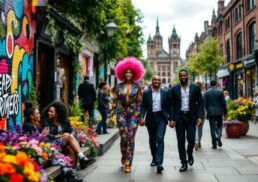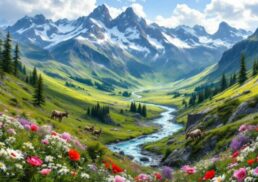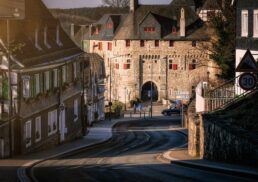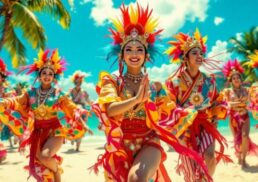Peru in South America is known for its ancient ruins, vibrant cultures, and diverse landscapes. This article covers Peru’s history, culture, and must-see destinations, offering a guide to what makes this country special.
Table of Contents
Key Takeaways
Peru’s rich history encompasses ancient civilizations like the Inca Empire and landmarks such as Machu Picchu and the Nazca Lines, reflecting a complex cultural heritage.
The country’s diverse geography includes the Andes Mountains, the Amazon rainforest, and coastal regions, each offering unique travel experiences and natural beauty.
Peru’s economy thrives on its mining sector, agriculture with high-value exports, and a flourishing tourism industry, all vital to its growth and global presence.
Peru in South America: History, Culture, and Must-See Destinations

Nestled along the Pacific Ocean, Peru stands as the third largest country in South America, boasting a tapestry of landscapes that captivate the soul: from the towering Andes to the sprawling Amazon rainforest. This is a nation that has witnessed the rise and fall of great civilizations, such as the Norte Chico and the Inca Empire, each leaving an indelible mark on the fabric of time. Southern Peru, just like its northern counterpart, offers a rich cultural and natural heritage worth exploring, as does neighboring northern Chile.
Peru’s culture is as diverse as its history, a melting pot of traditions and peoples. Here are some highlights of Peru’s culture:
The modern bustle of Lima
The silent grandeur of Machu Picchu
The vibrant festivals of the highlands
The tranquil waters of Lake Titicaca
Whether you’re drawn by the allure of history, the richness of cultural expression, or the call of the wild, Peru promises an adventure that transcends the ordinary.
Introduction
The contrasts and diversity inherent in Peru’s geography, culture, and history shape its unique essence. From the luxury of its coastal resorts to the rugged adventure awaiting in the Andes, Peru caters to every traveler’s dream. More than half of this captivating country is draped in the lush greenery of the Amazon, while its three distinct regions each offer a unique experience of the world.
With its official name, the Republic of Peru, the nation stands proud among South American countries. Its capital, Lima, is a hub of activity and culture, sitting on the west coast and serving as a gateway to the treasures that lie to the north, south, and deep within the region’s heart.
Geographic Overview of Peru

The marvel of Peru’s geography unfolds as:
The imposing Andes Mountains ascend to the skies
The mighty Amazon Basin sprawls under the vast canopy of one of the world’s most significant rainforests
This is a country that commands respect, with its highest peak, Mount Huascarán, reaching over 22,000 feet into the heavens.
The nation’s population clusters along the Pacific coast and the northern coast, where the vibrant culture and economic activity of cities like Lima pulse with life. Yet, travel inland, and you’ll encounter the heart of the Inca Empire and the serene beauty of the Amazon, each painting a different picture of the Peru current travelers come to experience.
Historical Insights
Peru’s historical narrative brims with tales of glory, conquest, and resilience. The Inca Empire, with Cusco as its capital, once stretched across the Andes, showcasing the ingenuity and might of its people. Before them, civilizations like the Moche and the Nasca laid the groundwork for a rich cultural heritage.
The Spanish conquest, a significant part of the Spanish Empire, brought an end to the Inca’s rule, but it also began a new chapter in Peru’s narrative, one that eventually led to its struggle for and achievement of independence after the Battle of Ayacucho in 1824. The remnants of these times still echo in Peru’s cities and ancient sites, a testament to a nation that has endured and flourished.
Cultural Diversity
Peru embodies a vibrant mosaic of cultures, seamlessly weaving the past and present into its social fabric. With the Peruvian flag symbolizing this unity, Peru’s population reflects this diversity, with a majority of Mestizo heritage and significant Amerindian, white, African, and Asian communities, each contributing to the national unity of Peru.
Some key facts about Peru’s population:
Majority of Mestizo heritage
Significant Amerindian, white, African, and Asian communities
Spanish serves as the lingua franca
Indigenous languages like Quechua and Aymara are honored with official status where they predominate.
Religion, particularly Roman Catholicism, weaves through the fabric of Peruvian society, influencing the celebration of festivals such as Inti Raymi and Semana Santa. These festivities, alongside the blend of indigenous traditions and colonial influences, create a rich cultural tapestry that is uniquely Peruvian.
Iconic Landmarks and Natural Wonders

Peru treasures an array of natural and man-made wonders, including:
The enigmatic ancient city of Machu Picchu in Northern Peru
The mysterious Nazca Lines
The biodiversity of the Sacred Valley
The dramatic vistas of the Andean highlands
Each landmark tells a story, inviting travelers to uncover the mysteries and marvel at the beauty of this ancient land.
Machu Picchu
Machu Picchu, a name that resonates with wonder and history, is a testament to the architectural prowess of the Inca Empire. Perched high in the Peruvian Andes, this UNESCO World Heritage Site was likely the estate of Emperor Pachacuti, constructed with precision and care that defies the centuries.
The site’s main structures, like the Temple of the Sun and the Intihuatana, are marvels of the classical Inca style, embodying the spiritual and cultural significance of Machu Picchu to the people of Peru. Standing among these ancient stones, one can almost hear the echoes of Inca civilization that continue to captivate and inspire the world.
Lake Titicaca
Lake Titicaca holds the title of the world’s highest navigable lake, a vast expanse of water that straddles the border between Peru and Bolivia. It’s a place of serenity and tradition, where indigenous communities live much as they have for centuries, with a deep connection to the land and the lake.
The cultural significance of Lake Titicaca is matched by its geographical importance, providing a unique ecosystem at high elevations where flora and fauna thrive. The lake is not just a destination; it’s an integral part of the Andean identity, a natural wonder that must be seen to be truly understood.
Rainbow Mountain
Rainbow Mountain, or Vinicunca, is a spectacle of nature, where layers of mineral-rich soil paint the landscape in hues of red, yellow, and green. This geological marvel, situated at a staggering 5,200 meters above sea level, is a relatively new discovery that has quickly become a must-see destination for those visiting Peru.
The journey to Rainbow Mountain offers:
A glimpse into the diversity of the Peruvian Andes
The rugged beauty of the high-altitude terrain
A place where the earth itself tells a story of time, pressure, and the artistic hand of nature.
Biodiversity and Nature Reserves
Peru’s dedication to conserving its natural heritage manifests in its standing as one of Earth’s most biodiverse countries. With over 20,375 species of flora and a ranking as the first in fish and butterfly species, Peru’s biodiversity is a treasure that enriches the planet.
The Amazon rainforest, a crown jewel of this biodiversity, is protected through reserves and conservation efforts led by the Ministry of Environment in Peru. The National Biodiversity Strategy and Action Plan serves as a roadmap for sustainable development and the safeguarding of Peru’s unique ecosystems for future generations.
Climate and Weather Patterns
The climate of Peru is as varied as its landscapes, with distinct weather patterns defining each of its three broad climatic regions:
The Coast enjoys a semi-arid climate.
The Andean Highlands experience a mix of rainy and dry seasons.
The Eastern lowlands boast a tropical climate with high temperatures and rainfall year-round.
Travelers can expect average temperatures ranging from the cool highs of the Andes to the warm lows of the Amazon, with variations in rainfall that create unique experiences in each region. This climatic diversity is part of what makes Peru an alluring destination, offering something for every type of adventurer.
Economic Landscape

With mining, agriculture, and tourism playing pivotal roles, Peru’s economy is a dynamic amalgamation of traditional and modern sectors. The country has experienced an economic boom, driven by its natural resources and the industrious spirit of its people. These economic activities not only drive growth but also define the nation’s place in the global market.
Mining Sector
The mining sector is a cornerstone of Peru’s economy, contributing to both GDP and government revenue. As the world’s second-largest producer of copper, Peru’s mining industry is a major player on the global stage, with copper projects accounting for a substantial portion of mining investments.
The recent record highs in copper output reflect the sector’s growth and its pivotal role in the country’s economic activities. This boom underscores the importance of mining to Peru’s overall economic health and its ability to attract foreign investment.
Agriculture
Agriculture is another pillar of Peru’s economy, with the country boasting over 4500 species of potatoes, a symbol of its rich agricultural heritage. The sector has seen remarkable growth in exports, attesting to the high-value crops that Peru offers to the world market.
This expansion has not only increased revenue but also created numerous jobs, highlighting the sector’s significant impact on the national economy and the livelihoods of many Peruvians. As a result, Peru’s agricultural landscape continues to evolve, with an increasing focus on sustainability and international competitiveness.
Tourism Industry
Tourism in Peru has flourished, becoming a vital part of the nation’s economic fabric and positioning the country as a top destination for international travelers. The allure of Peru’s attractions draws visitors from around the globe, including:
Ancient cities such as Machu Picchu and Cusco
Natural wonders like the Amazon rainforest and Lake Titicaca
Vibrant cultural experiences, including traditional festivals and indigenous communities
This thriving tourism industry contributes significantly to Peru’s economic growth, accounting for nearly half of the country’s income from the service sector.
The success of Peru’s tourism industry is a testament to the country’s ability to showcase its heritage and natural beauty while providing visitors with unforgettable experiences. This sector’s continued development is essential for driving economic diversification and promoting sustainable growth.
Government and Political Structure
Operating as a constitutional republic, Peru’s political system encompasses a president, a congress, and a supreme court. The president, elected by the people for a five-year term, wields considerable influence over the government, appointing the prime minister and shaping policy.
The legislative body, Congress, is tasked with creating laws and overseeing the national budget, while justices, nominated and confirmed through a comprehensive process, uphold the rule of law. This political structure, framed by the 1993 Constitution, reflects Peru’s commitment to democratic principles and the rule of law.
Practical Travel Information
When planning a Peruvian adventure, practical aspects such as currency exchange, transportation, and safety are vital considerations. Equipping yourself with the right knowledge will ensure a smooth and enjoyable experience as you delve into the wonders of this South American country.
Currency and Exchange
Peru’s currency, the Peruvian sol, is the lifeblood of transactions throughout the country. While credit cards are increasingly accepted, cash remains king, especially in smaller towns and for local purchases. Travelers should inform their banks about their travels to avoid any hitches with their cards, and ATMs, while prevalent, may charge fees higher than those at home.
To get the best exchange rates, it’s wise to shop around at banks, currency exchange offices, or even airports. Always compare rates and be aware that not all places will accept cards, so carrying enough cash to cover smaller expenses is advisable.
Transportation
Getting around Peru is an adventure in itself, with bus travel offering an extensive network that reaches even the most remote regions. Companies like Cruz del Sur provide comfortable and reliable services, making overland journeys a viable and often scenic option. In urban areas, ride-hailing apps like Uber provide a safe and convenient way to navigate the bustling city streets.
Whether you’re traversing the coastal desert or ascending to higher elevations in the Andes, the transportation landscape in Peru is diverse. Here are some of the modes of transport you can experience in Peru:
Traditional mototaxis
Modern trains
Buses
Taxis
Colectivos (shared taxis)
Ferries
Cable cars
Each mode of transport offers a unique perspective on the country’s varied terrain and culture.
Safety Tips
Staying safe during your travels is paramount, and in Peru, this starts with water consumption. Tap water is generally not safe to drink, so it’s advisable to use treated or bottled water to avoid any health issues. Additionally, political demonstrations can occur, and while they offer a glimpse into the country’s vibrant political landscape, it’s best to stay informed and steer clear of large gatherings for your safety.
Travel insurance is also highly recommended, providing peace of mind in case of medical emergencies or unexpected travel disruptions. Moreover, haggling is a common practice in markets, so don’t hesitate to negotiate prices, as they are often marked up with bargaining in mind.
Learn more, chackout What to do in Peru: 20 must-see attractions.
Summary
Peru, a land of ancient civilizations, vibrant cultures, and awe-inspiring natural wonders, offers an unparalleled journey into the heart of South America. From the majestic peaks of the Andes to the life-giving waters of the Amazon, from the sacred grounds of Machu Picchu to the reflective surface of Lake Titicaca, this country invites travelers to explore its rich history, diverse ecosystems, and dynamic economic landscape. As you plan your Peruvian adventure, remember the practical tips provided to ensure a safe and memorable experience. Let the spirit of Peru inspire and transform you, as it has so many who have traversed its varied and enchanting terrain.
Frequently Asked Questions
What is the best time of year to visit Machu Picchu?
The best time to visit Machu Picchu is during the dry season from May to August, when visibility is at its highest and the trails are safest to navigate. Avoid the rainy season for a better experience.
Are there any health precautions I should take before traveling to Peru?
Before traveling to Peru, make sure to get vaccinated against Yellow Fever, take precautions for altitude sickness, and only drink purified or bottled water to stay safe and healthy during your trip.
How do I navigate currency exchange in Peru?
When in Peru, you can exchange currency at airports, banks, or currency exchange offices. Compare rates, carry cash, and inform your bank about your travel plans for easy access to your funds.
Is it safe to travel in Peru?
Yes, it is generally safe to travel in Peru as long as standard safety precautions are taken, such as staying informed about the local political situation, avoiding tap water, and considering travel insurance for emergencies.
Can I use public transportation in Peru?
Yes, you can use public transportation in Peru by utilizing the extensive bus network for traveling between cities and remote areas, and using convenient options like Uber for city travel. Explore the variety of transportation methods available for a complete experience.









